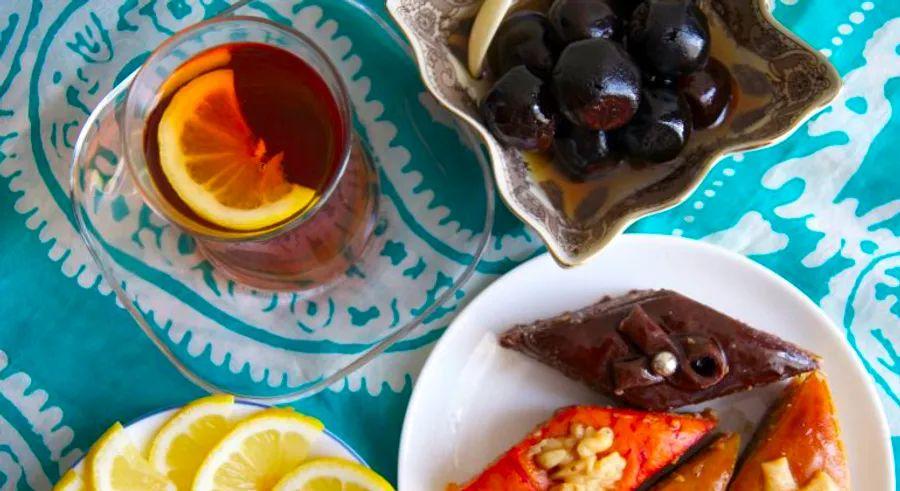Azerbaijan: A Gateway to Eastern Flavors

Azerbaijan’s culinary traditions stretch back over two millennia.
Located at the crossroads of East and West, along ancient Silk Road paths, this region has long been a meeting point for traders bringing spices, ingredients, and diverse culinary influences.
Today, Azerbaijan’s cuisine features a rich Eastern influence, closely aligned with neighboring Iran and Turkey. While kebabs and pilafs are indulgent and hearty, the country also boasts a bounty of fresh, nutritious fruits and vegetables.
Explore our guide to Azerbaijan’s vibrant food and drink culture.
Tea
It may seem unusual, but in the heat of summer, Azerbaijanis enjoy sipping hot tea, as it’s thought to naturally help cool the body down.
Even with the rise of coffee culture, tea remains the go-to drink to start the day for most Azerbaijanis.
In rural areas, tea is often brewed with keklikotu (oregano) or cinnamon. The water is heated in a traditional samovar, with burning tree branches infusing the water with a distinct woody fragrance.
Azerbaijani Breakfast

Although breakfast preparations may vary regionally, with each area adding its own special touch, the overall concept of breakfast remains largely the same across the country.
A colorful array of ingredients surround the highlight of the meal: freshly baked tandir bread.
Whether paired with honey and qaymaq (a rich cream), goat cheese, butter, or scrambled eggs with tomato, the crispy tandir bread complements all these delightful combinations perfectly.
To prepare scrambled eggs with tomato, finely chopped tomatoes are first sautéed until the pan is bubbling with their juices. Only then are the eggs added, resulting in a dish with a more liquid consistency than traditional scrambled eggs.
Served in a small skillet, the dish is enjoyed by dipping tandir bread into the savory blend of egg and tomato. The salt-free goat cheese on the side helps mellow out the saltiness, balancing the flavors.
Alternatively, kuku is a pie-like omelet, perfect for those who enjoy greens. Fresh coriander, dill, and green onions are finely chopped and mixed with five or six eggs, then fried in a pan until crispy.
Qutab

In terms of street food, Azerbaijan is famous for doners – Turkish-style meat sandwiches – but qutabs offer a lighter, equally delicious alternative.
Traditionally made with lavash (thin flatbread), the classic qutab is filled with minced meat. The vegetarian version might include pumpkin or fresh herbs like spinach, cilantro, onions, and dill, folded into a crescent shape and pan-fried without oil.
The qutabs, with their soft centers and crispy edges, are topped with tangy sumac and fresh pomegranate seeds (when in season). Both meat and herb varieties are served with ayran, a frothy sour yogurt drink mixed with water and salt. For those seeking a unique experience, there's also a smaller version filled with minced camel meat, known as jorat qutab.
Mangal Salad

One standout salad is mangal salad, named for the method of cooking its main ingredients – eggplant, bell pepper, and tomato – on a mangal, a traditional Caucasian grill.
Once the vegetables are roasted, they are chopped and combined with onions, cilantro, dill, olive oil, and purple basil – a unique herb in Azerbaijan. The salad is typically served chilled as a side dish to meat kebabs, helping to aid digestion of the rich meats.
Dovgha

This tangy, yogurt-based soup, which can be served hot or cold depending on the season, also includes rice, chickpeas, and a variety of finely chopped greens.
While the ingredients are simple, preparing this dish requires constant stirring to ensure the rice doesn’t stick to the bottom of the pot.
Levengi Chicken

Levengi chicken may look like a simple grilled chicken on the outside, but it hides a flavorful surprise inside.
The stuffing is a rich mixture of fried onions, roasted walnuts, raisins, dried plums, and pitted Cornelian cherries, all ground into a smooth paste. The blend of walnut richness and tangy plums creates an unforgettable taste.
Levengi stuffing can also be used to fill fish.
Dolma

Azerbaijani cookbooks feature a wide range of dolma recipes, with yarpaq (grape leaf) and uch baji (three sisters) being the most notable.
The yarpaq dolma is made with minced meat wrapped in grape leaves and slow-cooked, often served with qatiq (plain yogurt) and garlic on the side.
The uch baji version features a combination of aubergine, tomato, and bell pepper, stuffed with minced meat and cooked in their own juices. It is common to pair this dish with qatiq, as its probiotic properties aid digestion, especially for heavier meals.
Dessert

Azerbaijan’s most cherished pastries are traditionally made during March, the time of the Novruz spring festival.
Pakhlava, a diamond-shaped sweet pastry popular across the Middle East, is a favorite in Azerbaijan.
The Azerbaijani version, particularly the Sheki variety, is often softer and more indulgent than its counterparts.
Shorgoghal, a crispy, spice-filled pastry, can be either sweet (with white sesame seeds on top) or savory and salty (with black sesame seeds).
Shirin chorek, a sweet bread stuffed with nuts and dried grapes, is another popular treat.
Walnut preserve is one of the most unexpected yet delightful Azerbaijani desserts, often enjoyed alongside tea.
Walnuts are harvested while still green and tender, darkening as they are prepared. The nut’s rich texture combined with the sweetness of the syrup makes this a truly unforgettable treat.
Perhaps the most surprising and beloved food combination in Azerbaijan is watermelon, tangy goat cheese (the saltier, the better), and freshly baked tandir bread.
Though it may sound strange, once you experience the harmony of these flavors together, there’s no turning back.
Evaluation :
5/5



